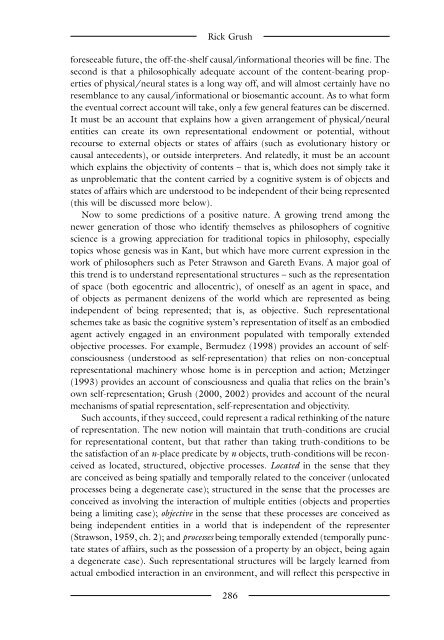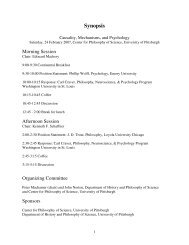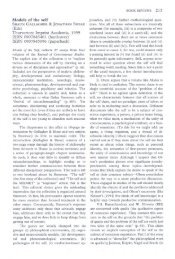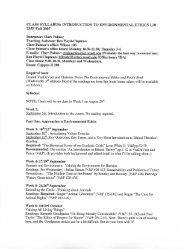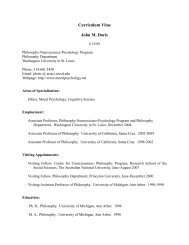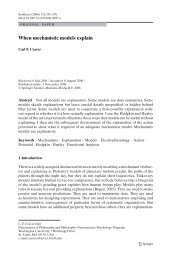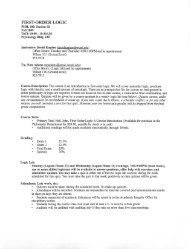The Blackwell Guide to the Philosophy of Science - The Department ...
The Blackwell Guide to the Philosophy of Science - The Department ...
The Blackwell Guide to the Philosophy of Science - The Department ...
Create successful ePaper yourself
Turn your PDF publications into a flip-book with our unique Google optimized e-Paper software.
Rick Grush<br />
foreseeable future, <strong>the</strong> <strong>of</strong>f-<strong>the</strong>-shelf causal/informational <strong>the</strong>ories will be fine. <strong>The</strong><br />
second is that a philosophically adequate account <strong>of</strong> <strong>the</strong> content-bearing properties<br />
<strong>of</strong> physical/neural states is a long way <strong>of</strong>f, and will almost certainly have no<br />
resemblance <strong>to</strong> any causal/informational or biosemantic account. As <strong>to</strong> what form<br />
<strong>the</strong> eventual correct account will take, only a few general features can be discerned.<br />
It must be an account that explains how a given arrangement <strong>of</strong> physical/neural<br />
entities can create its own representational endowment or potential, without<br />
recourse <strong>to</strong> external objects or states <strong>of</strong> affairs (such as evolutionary his<strong>to</strong>ry or<br />
causal antecedents), or outside interpreters. And relatedly, it must be an account<br />
which explains <strong>the</strong> objectivity <strong>of</strong> contents – that is, which does not simply take it<br />
as unproblematic that <strong>the</strong> content carried by a cognitive system is <strong>of</strong> objects and<br />
states <strong>of</strong> affairs which are unders<strong>to</strong>od <strong>to</strong> be independent <strong>of</strong> <strong>the</strong>ir being represented<br />
(this will be discussed more below).<br />
Now <strong>to</strong> some predictions <strong>of</strong> a positive nature. A growing trend among <strong>the</strong><br />
newer generation <strong>of</strong> those who identify <strong>the</strong>mselves as philosophers <strong>of</strong> cognitive<br />
science is a growing appreciation for traditional <strong>to</strong>pics in philosophy, especially<br />
<strong>to</strong>pics whose genesis was in Kant, but which have more current expression in <strong>the</strong><br />
work <strong>of</strong> philosophers such as Peter Strawson and Gareth Evans. A major goal <strong>of</strong><br />
this trend is <strong>to</strong> understand representational structures – such as <strong>the</strong> representation<br />
<strong>of</strong> space (both egocentric and allocentric), <strong>of</strong> oneself as an agent in space, and<br />
<strong>of</strong> objects as permanent denizens <strong>of</strong> <strong>the</strong> world which are represented as being<br />
independent <strong>of</strong> being represented; that is, as objective. Such representational<br />
schemes take as basic <strong>the</strong> cognitive system’s representation <strong>of</strong> itself as an embodied<br />
agent actively engaged in an environment populated with temporally extended<br />
objective processes. For example, Bermudez (1998) provides an account <strong>of</strong> selfconsciousness<br />
(unders<strong>to</strong>od as self-representation) that relies on non-conceptual<br />
representational machinery whose home is in perception and action; Metzinger<br />
(1993) provides an account <strong>of</strong> consciousness and qualia that relies on <strong>the</strong> brain’s<br />
own self-representation; Grush (2000, 2002) provides and account <strong>of</strong> <strong>the</strong> neural<br />
mechanisms <strong>of</strong> spatial representation, self-representation and objectivity.<br />
Such accounts, if <strong>the</strong>y succeed, could represent a radical rethinking <strong>of</strong> <strong>the</strong> nature<br />
<strong>of</strong> representation. <strong>The</strong> new notion will maintain that truth-conditions are crucial<br />
for representational content, but that ra<strong>the</strong>r than taking truth-conditions <strong>to</strong> be<br />
<strong>the</strong> satisfaction <strong>of</strong> an n-place predicate by n objects, truth-conditions will be reconceived<br />
as located, structured, objective processes. Located in <strong>the</strong> sense that <strong>the</strong>y<br />
are conceived as being spatially and temporally related <strong>to</strong> <strong>the</strong> conceiver (unlocated<br />
processes being a degenerate case); structured in <strong>the</strong> sense that <strong>the</strong> processes are<br />
conceived as involving <strong>the</strong> interaction <strong>of</strong> multiple entities (objects and properties<br />
being a limiting case); objective in <strong>the</strong> sense that <strong>the</strong>se processes are conceived as<br />
being independent entities in a world that is independent <strong>of</strong> <strong>the</strong> representer<br />
(Strawson, 1959, ch. 2); and processes being temporally extended (temporally punctate<br />
states <strong>of</strong> affairs, such as <strong>the</strong> possession <strong>of</strong> a property by an object, being again<br />
a degenerate case). Such representational structures will be largely learned from<br />
actual embodied interaction in an environment, and will reflect this perspective in<br />
286


